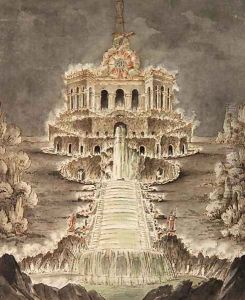Heinrich Christoph Jussow Paintings
Heinrich Christoph Jussow was a German architect and landscape designer, known primarily for his contribution to the English Garden at Wilhelmshöhe, now a part of Kassel, Germany. Born on February 9, 1754, in Kassel, Jussow grew up in an era when the aesthetics of neoclassicism and romanticism were flourishing across Europe. His work is often associated with the transformation of garden design during this period, reflecting the transition from formal Baroque styles to more naturalistic landscapes.
Jussow embarked on an educational journey typical for architects of his time, which included extensive travels to study classical antiquities first-hand. In Italy, he was deeply influenced by the ancient ruins and the Renaissance architecture, an experience that would later inform his own architectural style. After his return to Germany, Jussow worked under the Landgrave Wilhelm IX of Hesse-Kassel (later Elector Wilhelm I), a patron of the arts who supported Jussow’s vision for the extensive park at Wilhelmshöhe.
Among his most notable works is the Löwenburg (Lion's Castle), a mock medieval knight's castle built from 1793 to 1801, which was part of the larger Wilhelmshöhe Park landscape. This romantic structure was designed to appear as a ruin, blending with the surrounding nature and serving as a picturesque focal point of the park. Jussow's innovative approach to the Löwenburg and other projects within Wilhelmshöhe Park was indicative of the changing tastes of the time, as emphasis was placed on emotion, individual experience, and harmony with nature.
Jussow's contribution to the field of landscape architecture extends beyond his individual projects. He was instrumental in introducing the English garden style to Germany, which emphasized organic, irregular designs that contrasted with the geometric precision of French formal gardens. His influence helped to spread this style throughout the country, affecting the development of landscape design in the region.
Heinrich Christoph Jussow died on June 18, 1825, in Kassel. Despite being less well-known than some of his contemporaries, Jussow’s work at Wilhelmshöhe remains a testament to his skill and vision, blending architecture with the natural world to create environments that were both innovative and reflective of the romantic spirit of his time.
